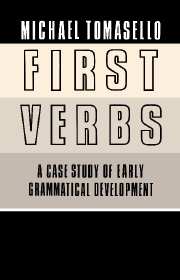Book contents
- Frontmatter
- Contents
- Acknowledgments
- Dedication
- 1 Introduction
- 2 In the beginning was the verb
- 3 Methods and an introduction to T's language
- 4 Change of state verbs and sentences
- 5 Activity verbs and sentences
- 6 Other grammatical structures
- 7 The development of T's verb lexicon
- 8 The development of T's grammar
- 9 Language acquisition as cultural learning
- References
- Appendix
- Index
7 - The development of T's verb lexicon
Published online by Cambridge University Press: 18 December 2009
- Frontmatter
- Contents
- Acknowledgments
- Dedication
- 1 Introduction
- 2 In the beginning was the verb
- 3 Methods and an introduction to T's language
- 4 Change of state verbs and sentences
- 5 Activity verbs and sentences
- 6 Other grammatical structures
- 7 The development of T's verb lexicon
- 8 The development of T's grammar
- 9 Language acquisition as cultural learning
- References
- Appendix
- Index
Summary
In chapters 4 and 5, my focus was on the details of how T learned and used each one of her first verbs. In this chapter my aim is to extract from these detailed analyses some more general patterns in the development of T's verb lexicon. In particular I focus on general patterns in the cognitive structures underlying T's early verbs, and general patterns in the social–pragmatic contexts in which T learned her early verbs. In both cases there are marked differences between verbs and the more commonly studied word class of nouns. In a final section of the chapter, I attempt to make clear the implications of these differences for theories of lexical acquisition and development.
Cognitive bases of T's early verbs
Table 7.1 lists all of the 162 relational words and verbs T learned prior to her second birthday, organized according to conceptual category and age of first productive use. As stated previously, the conceptual categories are not posited as a part of T's grammatical system; they are a heuristic for researchers and, at most, may depict something of the conceptual relatedness of these linguistic items for T. It should be noted that T's presymbolic forms are not listed, but her words that were originally presymbolic and then symbolic are listed (under the date of their first symbolic uses). As in the previous detailed analyses, the most productive approach to these data is to consider change of state and activity verbs separately.
Change of state verbs
The major conceptual distinctions underlying T's acquisition of change of state verbs are presented in Table 7.2, as a function of semantic domain and age in months.
- Type
- Chapter
- Information
- First VerbsA Case Study of Early Grammatical Development, pp. 187 - 221Publisher: Cambridge University PressPrint publication year: 1992



